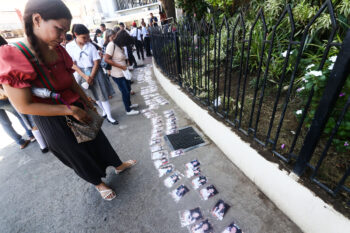MALAYBALAY CITY (MindaNews/15 Sept) – Small-scale gold miners in at least 58 hectares in the municipality of Libona in Bukidnon being financed by foreigners are operating illegally and using mercury and cyanide, an environment official said.
Samuel Cadavos, chief of the Bukidnon Environment and Natural Resources Office (BENRO), warned members of the Sangguniang Panlalawigan that the mining operations in Sitio Manlahuyan, Gango in Libona has become a complex “social, technical, environmental and political” problem.
“I ask your help to stop this problem,” he appealed to the provincial board members.
Cadavos noted that he has ordered several times the closure of the mine sites but operations keep on recurring. He warned that the operators are now armed and resisting government attempts to stop mining activities in the area.
Two groups of operators are running the mining sites – the Bukidnon Integrated Small-Scale Miners Association (BISSMA) and the Bukidnon United Small Scale Miners Association (BUSMA) – with at least 2,000 miners. But none of them obtained a valid small-scale mining permit at the provincial government, Cadavos said.
The operations, he added, include prospecting, exploration, actual extraction of gold ore from tunnels, and processing and recovery of gold using mercury and cyanide.
He said when they investigated, the latest on August 23, they found ball mills, rod mills and a carbon in-pulp plant used in processing and recovering gold, which they used aside from the common tailings pond constructed by the province.
The BENRO chief cited three Chinese nationals allegedly involved in illegal “mineral trading operations” – Harrison Chen of the Cagayan de Oro-based firm Ore Group International Mining Corporation, Ke Liang We of Wilson Minerals Corporation and a “Chinese investor named Mr. Bill Ho.”
Cadavos quoted Chen as saying the latter’s group had released P15 million to Alvin Shi, who runs WHK Manufacturing and Trading Corporation.
WHK, Cadavos said, was allowed to enter the area because it has a memorandum of agreement with the local government unit of Libona for WHK to clean the tailings pond. Although the MOA was for WHK to do the cleaning, it now appears that the firm has illegally gone into gold processing as well as investigators noted that there are now structures for mineral processing being used by WHK. Investigators also found sacks of extracted gold ore in the processing site.
BENRO, Cadavos said, has advised WHK to stop and secure requirements prior to any mining operation.
But WHK’s Shi denied they were in for gold.
In 1986, small-scale miners began to operate in the area, previously proposed for “minahan ng bayan.” Cadavos said the provincial government through the Provincial Mining Regulatory Board (PMRB) during the administration of former governor, now vice governor, Jose Maria R. Zubiri Jr.
“However, until this time there was no official communication received from the DENR (Department of Environment and Natural Resources) regarding status of their application,” Cadavos said.
He noted the problem why a small-scale mining permit cannot be issued. He said the same area is also inside the 2,000-hectare Industrial Forest Management Agreement the DENR awarded to the Pelaez family.
“Hence there is conflict in terms of land use, conflict between the intention of industrial plantation and mining operation over the same piece of land,” Cadavos added.
The Mines and Geosciences Bureau of the DENR-10 issued a cease and desist order (CDO) against illegal mining and illegal mineral processing in the area as of August 3, 2011. Alfredo Relampagos, MGB regional director who signed the order, also warned about the common tailings pond in the area.
He said it is now “very full” resulting to the overspilling of silted water. Based on an MGB team’s report of its investigation in July, Relampagos said that silted water spilled into the nearby Bigaan River. He said the BENRO should encourage and supervise the plan to desilt and rehabilitate the tailings pond to avoid “possible disaster.”
“A crack was observed at the base of Dike 2. BENRO, as well as all the CIP (carbon in-pulp plant) operators, should repair immediately the crack to prevent the dike’s possible collapse,” he said.
Relampagos wrote to Cadavos on Aug. 12 that they found spillage of effluents containing mercury and cyanide and sediments from the pond resulting in a “very high total suspended solids.”
Cadavos described the situation in his Sept. 14 report to the SP as “increase on mercury contamination.” He called on a multi-partite stakeholders’ dialogue to address the “multi-faceted problem.”
Cadavos has ruled out recommending closure of the mines because “it would mean loss of livelihood.”
“We are looking at having it declared as a ‘minahan ng bayan’ so we can regulate it,” he added.
Vice Gov. Jose Ma. R. Zubiri led provincial board members to an on-site visit Thursday to meet with local government officials, mine operators, and the alleged foreign investors. (Walter I. Balane / MindaNews)
